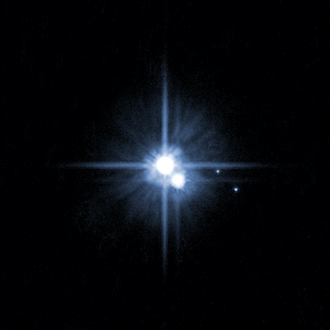New Pluto moon likely to be named Vulcan, thanks to William Shatner
P4 and P5 are closer to getting proper names
In 2005, this image from NASA’s Hubble Space Telescope was used to identify two new moons orbiting Pluto. Pluto is in the center. The moon Charon is just below it. The newly discovered moons, Nix and Hydra, are to the right of Pluto and Charon. Image Credit: NASA, ESA, H. Weaver (JHU/APL), A. Stern (SwRI), and the HST Pluto Companion Search Team
Share

One of the most recently discovered Pluto moons will likely be named Vulcan, thanks to a little help from Star Trek actor William Shatner.
Earlier this month, scientists asked for help naming the moons formerly know as P4 and P5 though an online vote at plutorocks.com.
People could vote from a list or add their own name. The only caveat was that the names should come from Greek or Roman mythology, to remain in line with the names of the three previously discovered Pluto moons: Nix, Charon and Hydra.
The top two picks when voting ended were Vulcan and Cerberus.
Vulcan was not on the original list of choices, but it was added after Shatner prompted his more than one million Twitter followers to add Vulcan to the list.
Did you hear?They added the name Vulcan to the list of possible names for Pluto’s moons!You did it!I’m so happy. plutorocks.com/home
— William Shatner (@WilliamShatner) February 13, 2013
In Star Trek, Vulcan is the planet from which the character Spock hails. In ancient Rome, Vulcan is the god of volcanoes and fire.
The names that received the most votes still have to be approved, something that could take one to two months, according to researcher Mark Showalter.